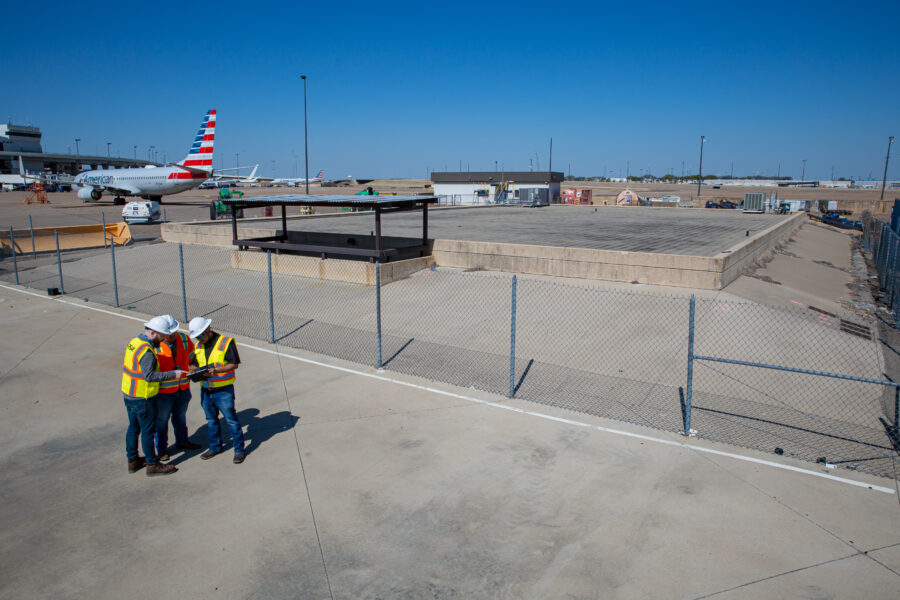As PFAS Concerns Grow, What Can Your Airport Do?

The PFAS probe has officially begun. Since the start of this year, the U.S. Federal Aviation Administration (FAA), Environmental Protection Agency (EPA), Florida Department of Environmental Protection (FDEP), and California Water Boards – among others – have put plans in place to try to gain a better understanding of how PFAS are affecting Americans.
The contamination from per- and poly-fluorinated alkyl substances, or PFAS, has emerged as a serious concern over the last year, consuming the news and creating a labyrinth of work for PFAS-affected industries – including airports.
PFAS are a group of more than 3,000 manmade chemicals that can be found in a variety of products across many industries, from stain-repellent carpeting to non-stick cookware. In the aviation industry, PFAS are a small but essential part of aqueous film-forming foams (AFFFs), which are used at airports, military facilities, and refineries where large amounts of flammable fuel are present.
While PFAS chemicals are extremely effective in extinguishing high intensity fires, they have been found to be more pervasive in the environment and more detrimental to human health than we perhaps realized. In 2016, the EPA issued a drinking water health advisory standard for the two key PFAS chemicals – perfluorooctane sulfonate (PFOS) and perfluorooctanoic acid (PFOA) of 70 parts per trillion (ppt) combined. Congress, the EPA, and individual states are stepping up efforts amidst growing concern over the danger of these chemicals.
EPA Takes Action
On the heels of the announcement of a bipartisan Congressional PFAS Task Force, the EPA followed suit, launching the first-ever PFAS Action Plan earlier this year.
“The PFAS Action Plan is the most comprehensive cross-agency plan to address an emerging chemical of concern ever undertaken by EPA,” the EPA announced. “For the first time in Agency history, we utilized all of our program offices to construct an all-encompassing plan to help states and local communities address PFAS and protect our nation’s drinking water.”
Since announcing the plan in February, the EPA has issued further guidance on PFOA and PFOS cleanup efforts and will likely designate PFOA and PFOS as hazardous substances under the Comprehensive Environmental Response, Compensation, and Liability Act (CERCLA). The memo provides clarity for those already undergoing remediation efforts, giving recommendations to address screening levels and initial remediation goals for groundwater contaminated with PFOA and PFOS.
Significantly, the memo states the EPA will apply a hazard quotient of 0.1 to each of the chemicals separately, which results in a groundwater screening level of 40 ppt for PFOS and PFOA individually. Currently, the health advisory (HA) level is 70 ppt combined PFOS and PFOA.
To illustrate the significance, imagine this example: A groundwater area used for the region’s public drinking water supply lies beneath an area where PFAS contamination is suspected. The water is sampled, and the test results show 69 ppt of PFOS and 0 ppt of PFOA. Under the current rules, this is acceptable, and an HA would not be enforced. Under the proposed rules, an HA recommending the public not drink the water would be issued for PFOS because the amount is greater than 40 ppt.
FAA Addresses Growing Concern
Additionally, the FAA began efforts earlier this year to help mitigate the potential hazards of AFFFs and placate growing concerns. The agency issued Part 139 Cert Alert 19-01 to give airports alternatives to the biannual AFFF testing that was previously required. The cert alert provides options and recommendations for AFFF testing, including options that do not require foam to be discharged onto the ground during testing of ARFF vehicles.
Currently, there are no fluorine-free foams that match the performance of fluorinated foams; however, the FAA addressed its continued research to find an environmentally friendly yet effective firefighting foam, going as far as constructing a new research facility devoted to testing for AFFF alternatives.
California Leads State Efforts
The California Water Boards announced in March its own PFAS Action Plan. The plan includes issuing orders to more than a thousand facilities in California requiring investigation and sampling for PFAS. The investigation plan will be implemented in phases, with phase 1 including 31 airports throughout the state.
The orders issued by the State Board will require airports to perform several tasks under a very short timeline. Within 30 days of receiving orders, airports must respond to a questionnaire regarding use of products containing PFAS. Within 60 days, airports must submit work plans for performing testing. Once the plans are accepted, airports will have 90 days to perform testing and submit results.
Florida DEP Initiates Review and Develops Provisional Standards
The FDEP issued response letters requiring responsible parties to delineate contamination of all affected media, and to provide notice to affected property owners, when required. FDEP began its request of Certified Fire Training Facilities across the State and will likely expand that request to all public facilities, including airports.
FDEP, pursuant to Chapters 373 and 403, Florida Statutes (F.S.), and the rules promulgated thereunder in Chapter 62-780, Florida Administrative Code (F.A.C.), has derived provisional groundwater cleanup target levels (GCTLs) and soil cleanup target levels (SCTLs) for PFOA and PFOS and is working to develop surface water levels.
How Airports Can Respond
While national organizations such as the Airports Council International-North America (ACI-NA) and American Association of Airport Executives (AAAE) are urging Congress to take precaution on mandates surrounding PFAS, airports will likely need to take some action, especially as states mandate investigations and cleanup levels.
Already stretched thin on staff and budget, airport operators need to prepare now in order to adequately respond to orders for PFAS testing and remediation. Here are a few steps airports can take now to prepare.
1. Engage your team
Develop the right team within your organization to promote an efficient and collaborative response process. PFAS management needs the right mix of staff and may include:
• Airport leadership to ensure a broad understanding of the issue
• Environmental personnel with an understanding of the issue and investigative details and processes, and who have relationships with regulators
• ARFF personnel who know where PFAS may have been used
• Maintenance personnel who manage AFFF inventory and know how waste is managed
• Other long-term existing and prior staff with knowledge of potential releases
• Legal staff
• Outside consultants who can help develop a PFAS management strategy
2. Develop a management, regulatory and public relations strategy
Moving forward, airport staff will likely need to engage state environmental regulatory agencies. Developing a collaborative relationship creates an understanding of each other’s priorities and can guide next steps. However, it is important to establish a plan prior to engaging regulators, so you can lead the conversation.
Additionally, create a public engagement strategy to address the growing public concern.
3. Pinpoint airport AFFF-use locations
A great initial step that is not too costly is to understand potential PFAS sources. Airports should pinpoint current and historic fire training locations, hangar with foam suppression systems, crash sites and testing areas, and determine current and historic management practices for waste AFFF. Next, they should create an inventory of AFFFs being used, along with a manufacture date. AFFFs manufactured prior to 2002 could contain longer-chain PFAS and should be removed from use and stored in a safe place until guidelines for disposal are better developed.
Airports should also identify potential non-aviation sources of PFAS. PFAS are widely used and it’s important to identify off-site sources that may cloud the results of investigations. It has been recommended to develop a sort of “fingerprinting” for the source of PFAS since they have been so commonly used.
4. Identify nearby PFAS pathways
Identifying potential PFAS pathways around the site is key in understanding the risk to human health. The primary PFAS pathway to humans is ingestion, most commonly through drinking water and possibly eating food (such as fish) with high levels of PFAS.
With that in mind, identify nearby drinking water sources, surface water bodies, sensitive biological resources (wetlands), and the basic geology (groundwater depth, direction of flow, soil/bedrock type) underlying the potential source areas. Additional testing will likely be needed in these areas.
5. Look to your airport’s future development
Your facility can save both time and money by identifying where any potential source areas are in relation to future construction sites.
If construction projects have the potential to impact PFAS-containing soils or groundwater, a soils management and dewatering plan should be developed. Plans that keep potentially contaminated soils onsite and prevent them from moving closer to receptors and pathways should be given preference.
What’s Next?
Next steps are largely unknown. Organizations such as the ACI-NA and AAAE are urging the government to be prescriptive in how to handle the growing dilemma and how to fund future cleanup efforts. The EPA, FAA, and Congress must work together to reach a better scientific understanding of the health advisory levels and the sources and alternatives of PFAS, as well as appropriate technologies for remediation and disposal.
Engaging environmental experts to help navigate this multifaceted process is a proactive step airport operators can take until there are tangible answers. Disposal and remediation best practices remain unsolved but taking the steps above to begin identifying and containing potential harm can only have positive results.




